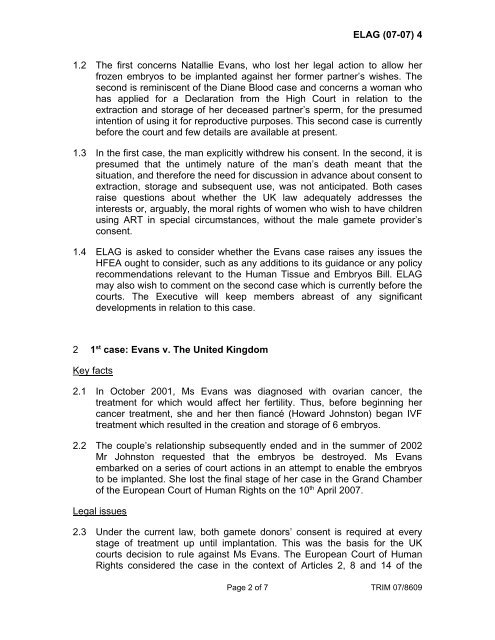Bilateral consent to use sperm/embryos for reproductive purposes
Bilateral consent to use sperm/embryos for reproductive purposes
Bilateral consent to use sperm/embryos for reproductive purposes
You also want an ePaper? Increase the reach of your titles
YUMPU automatically turns print PDFs into web optimized ePapers that Google loves.
ELAG (07-07) 41.21.31.4The first concerns Natallie Evans, who lost her legal action <strong>to</strong> allow herfrozen <strong>embryos</strong> <strong>to</strong> be implanted against her <strong>for</strong>mer partner’s wishes. Thesecond is reminiscent of the Diane Blood case and concerns a woman whohas applied <strong>for</strong> a Declaration from the High Court in relation <strong>to</strong> theextraction and s<strong>to</strong>rage of her deceased partner’s <strong>sperm</strong>, <strong>for</strong> the presumedintention of using it <strong>for</strong> <strong>reproductive</strong> <strong>purposes</strong>. This second case is currentlybe<strong>for</strong>e the court and few details are available at present.In the first case, the man explicitly withdrew his <strong>consent</strong>. In the second, it ispresumed that the untimely nature of the man’s death meant that thesituation, and there<strong>for</strong>e the need <strong>for</strong> discussion in advance about <strong>consent</strong> <strong>to</strong>extraction, s<strong>to</strong>rage and subsequent <strong>use</strong>, was not anticipated. Both casesraise questions about whether the UK law adequately addresses theinterests or, arguably, the moral rights of women who wish <strong>to</strong> have childrenusing ART in special circumstances, without the male gamete provider’s<strong>consent</strong>.ELAG is asked <strong>to</strong> consider whether the Evans case raises any issues theHFEA ought <strong>to</strong> consider, such as any additions <strong>to</strong> its guidance or any policyrecommendations relevant <strong>to</strong> the Human Tissue and Embryos Bill. ELAGmay also wish <strong>to</strong> comment on the second case which is currently be<strong>for</strong>e thecourts. The Executive will keep members abreast of any significantdevelopments in relation <strong>to</strong> this case.21 st case: Evans v. The United KingdomKey facts2.12.2In Oc<strong>to</strong>ber 2001, Ms Evans was diagnosed with ovarian cancer, thetreatment <strong>for</strong> which would affect her fertility. Thus, be<strong>for</strong>e beginning hercancer treatment, she and her then fiancé (Howard Johns<strong>to</strong>n) began IVFtreatment which resulted in the creation and s<strong>to</strong>rage of 6 <strong>embryos</strong>.The couple’s relationship subsequently ended and in the summer of 2002Mr Johns<strong>to</strong>n requested that the <strong>embryos</strong> be destroyed. Ms Evansembarked on a series of court actions in an attempt <strong>to</strong> enable the <strong>embryos</strong><strong>to</strong> be implanted. She lost the final stage of her case in the Grand Chamberof the European Court of Human Rights on the 10 th April 2007.Legal issues2.3Under the current law, both gamete donors’ <strong>consent</strong> is required at everystage of treatment up until implantation. This was the basis <strong>for</strong> the UKcourts decision <strong>to</strong> rule against Ms Evans. The European Court of HumanRights considered the case in the context of Articles 2, 8 and 14 of thePage 2 of 7 TRIM 07/8609
















